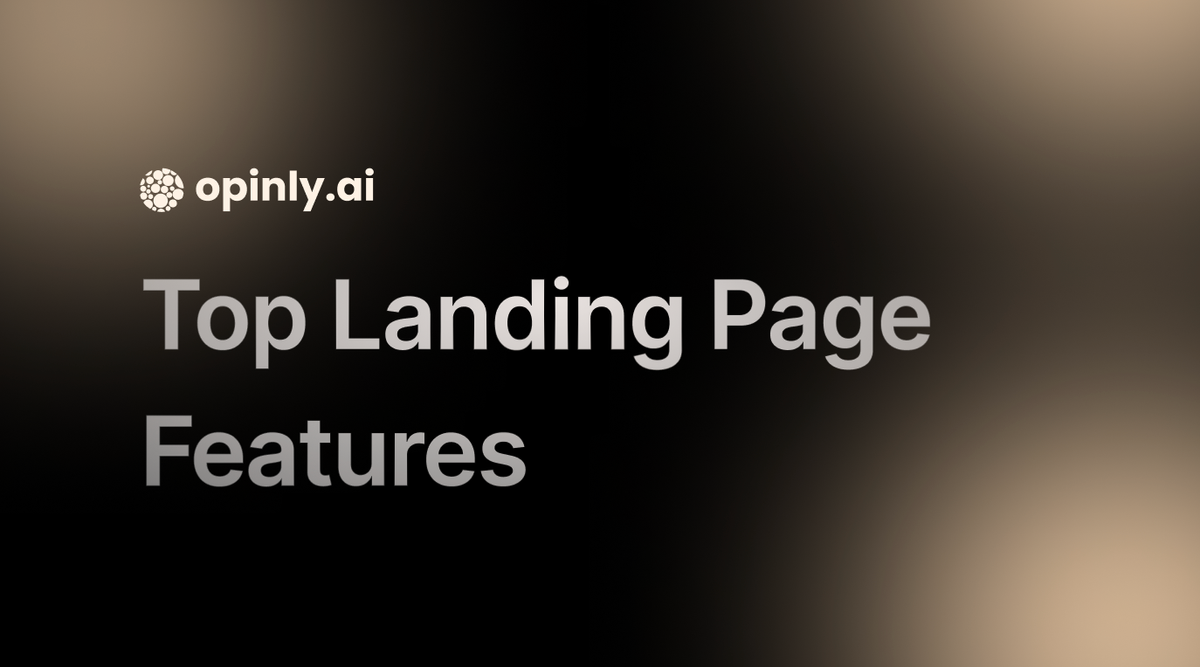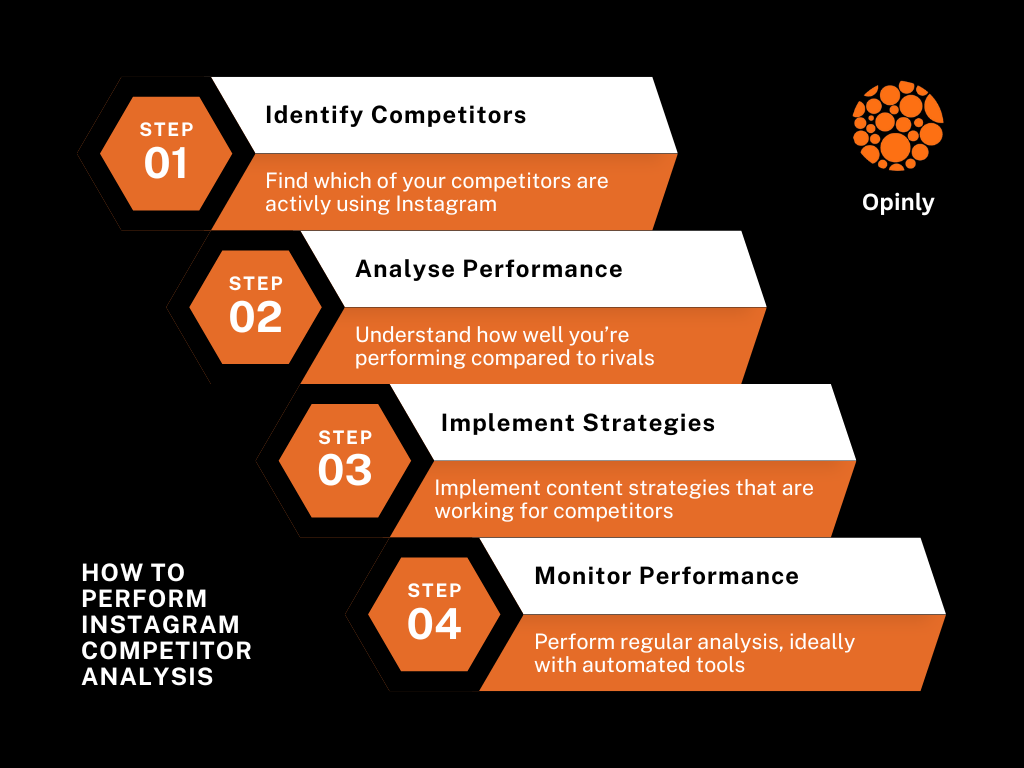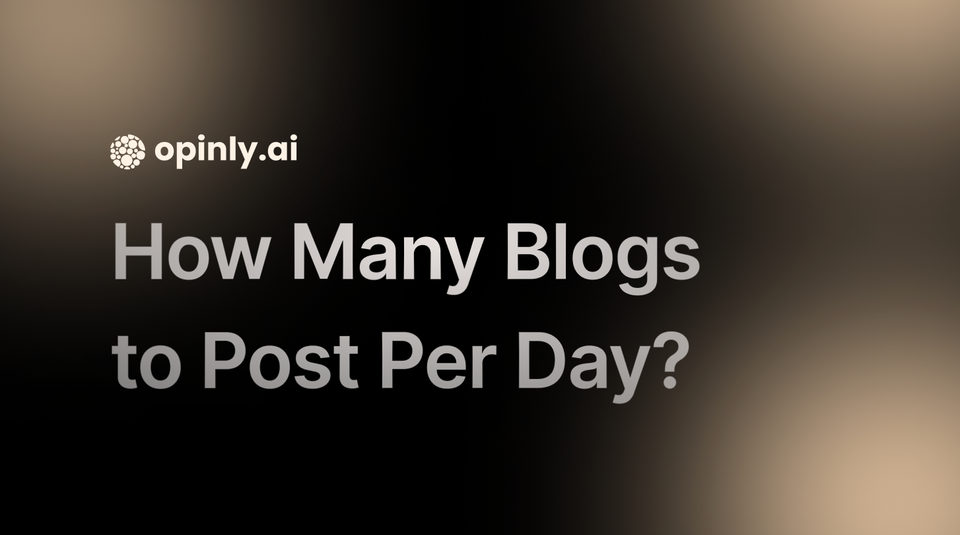Top 10 Features of High-Converting Landing Pages
The top features that make competitor comparison landing pages successful for B2B SaaS companies. Boost your conversion rate with these key strategies!

Understanding what makes competitor landing pages successful is essential for any business looking to improve its online conversions.
Landing pages are the first impression potential customers have of your SAAS business, and getting them right can mean the difference between a bounce and a sale. Consider adding competitor comparison keywords to improve SEO performance.
A competitive analysis needs to go much deeper than looking at your competitors' social media or advertising efforts for comparison. Take a look into their history, who they consider their closest competitor and where they’re succeeding and falling short on selling their products. Christopher Tompkins
By examining what high-converting competitor comparison landing pages have in common, you can apply these feature comparison strategies to your own pages and see significant improvements in your conversion rates.
In this article, we'll explore the top ten features that set high-converting competitor landing pages apart.
These features are the building blocks of effective landing pages and include everything from compelling headlines, competitor keywords, organic search volume, and strong visual appeal to trust signals and clear value propositions.
We'll also look at the importance of user-friendly forms, search result funnel, responsive design, and the role of A/B testing in optimizing page performance.
Additionally, we’ll cover how comparison table, social proof and clear messaging contribute to making a landing page more effective.
By the end of this article, you'll have a clear understanding of the key elements that make competitor landing pages convert so well.
You can then incorporate these insights into your own landing pages, helping you to attract more leads, boost your sales, and grow your B2B SaaS business by improving your search engine rankings and optimizing your SEO.
Let’s dive in and uncover the secrets behind how to create competitor comparison pages and high-converting landing pages!
1. Compelling Headlines
A powerful headline is the first thing visitors notice when they land on your page. Create these pages to grabs attention and clearly communicate the value proposition of the page to rank, setting the stage for the rest of the content.
A compelling headline can make the difference between a prospect staying to learn more or leaving immediately. Here’s what makes headlines on high-converting landing pages so effective:
- Clear and Concise: The best headlines are straightforward and easy to understand. They avoid jargon and get straight to the point, making it immediately clear what the page is about. Your target audience should be able to grasp the main message in just a few seconds.
- Benefit-Oriented: High-converting headlines focus on the benefits the visitor will receive. Instead of just stating what the brand name product or service is, they highlight what the user will gain. They might also make a true comparison to competitors. This might be saving time, improving productivity, or achieving better results more efficiently, making it particularly relevant for SaaS companies.
- Engaging and Compelling: An engaging headline piques the visitor's interest and compels them to keep reading. It might ask a question, make a bold statement, or promise a solution to a problem. The goal is to create curiosity and draw the reader in.
For example, instead of a generic headline like "Our Software," a compelling headline would be "Boost Your Productivity with Our Time-Saving Software." This headline is clear, focuses on the benefit of increased productivity, and is engaging by promising a specific outcome.
By creating pages with effective headlines that are clear, benefit-oriented, and engaging for search intent, you can significantly increase the chances that visitors will stay on your page and take the next step, whether that's signing up for a newsletter, downloading a guide, or making a purchase.
2. Strong Comparison Landing Page Visual Appeal
Visual elements are key to keeping visitors engaged on your landing page. Humans are visual creatures, and the right images, colors, and layout can make a significant difference in how a landing page performs.
Competitor landing pages with high conversion rates typically have the following visual features:
- High-Quality Images and Graphics improve user engagement and can contribute to better search engine visibility: The use of high-resolution images and professional graphics makes a page look polished and credible. These images should be relevant to the content and help to illustrate key points or benefits. Avoid stock photos that look generic; instead, opt for images that reflect your brand's personality and message.
- Consistent Brand Colors and Fonts: Consistency in colors and fonts helps to create a cohesive and professional look. Use your brand's color palette and typography throughout the landing page to reinforce brand identity. The strengths and weaknesses of color consistency not only makes the page visually appealing but also help in building brand recognition.
- Clean and Uncluttered Design: A clean design is easy on the eyes and helps visitors focus on the important information. Avoid clutter by using plenty of white space and keeping the design elements simple. This makes the page more readable and ensures that the key messages and purchase decision calls-to-action stand out.
For example, instead of crowding the product comparison page with too much text and numerous images, a high-converting direct comparison landing page might feature a single, striking hero image at the top, followed by a clean layout that guides the visitor’s eye naturally down the page.
The use of consistent colors and fonts ties everything together, creating a seamless visual experience.
By focusing on high-quality visuals, maintaining consistency with your brand, and keeping the design clean, you can create a landing page that not only looks great but also enhances the visitor's experience, making them more likely to convert to your SAAS product.
3. Trust Signals
Building trust with visitors is essential for boosting conversions on your landing page. When visitors feel confident in your brand and believe that others have had positive experiences, they are more likely to take action.
Effective landing pages often include various trust signals to establish credibility and reliability.
Here are some common trust signals that can make a significant impact:
- Customer Testimonials: Testimonials from satisfied customers provide social proof that your product or service delivers on its promises, enhancing both SEO and search engine visibility. Featuring quotes or short stories from real customers helps potential buyers feel reassured about their decision. Make sure to include the customer’s name, photo, and, if possible, their company or location to add authenticity.
- Case Studies: Detailed case studies show how your product or service has helped other customers achieve their goals. They provide in-depth examples of success, highlighting specific challenges and how your solution addressed them. Case studies are particularly effective for B2B landing pages where potential clients want to see concrete evidence of your capabilities, especially in SaaS companies.
- Trust Badges: Trust badges, such as SSL certificates, awards, and security seals, signal that your website is safe and reliable. These badges often include logos from well-known organizations or certifications, which can help reassure visitors about the security of their data and the legitimacy of your business. For example, displaying a “Secure Checkout” badge can reduce concerns about online payment security.
For instance, if you have won industry awards, showcasing these on your landing page can significantly enhance your credibility. Similarly, logos of recognizable clients or partners can serve as powerful endorsements, further building trust.
By incorporating customer testimonials, detailed case studies, and visible trust badges, you can create a landing page that feels trustworthy and reliable. This trust encourages visitors to take the desired action, whether it’s making a purchase, signing up for a service, or providing their contact information.
4. Effective Call-to-Action (CTA)
The Call-to-Action (CTA) is arguably the most important element on a landing page. It directs visitors on what to do next and can make or break your conversion rates. High-converting landing pages feature CTAs that are carefully crafted to encourage visitors to take action. Here’s what makes an effective CTA:
- Highly Visible and Strategically Placed to attract more clicks and improve your SEO.: The CTA should be easy to find and impossible to miss. This means placing it above the fold, so visitors see it without having to scroll. Additionally, consider placing multiple CTAs throughout the page, especially after key pieces of information. The button should stand out with a contrasting color that draws the eye, ensuring it grabs attention immediately.
- Action-Oriented and Persuasive: The language of the CTA should be clear and compel the visitor to act. Instead of generic phrases like "Click Here," use specific, action-oriented words that convey the benefit or action, such as "Get Your Free Trial," "Download Now," or "Start Saving Today." The CTA should create a sense of urgency or excitement, motivating visitors to act immediately rather than putting it off.
- Supported by Compelling Copy: The text surrounding the CTA should reinforce its message and persuade visitors to take the next step. This means clearly stating what the visitor will get and how it benefits them. For instance, if the CTA is for a free trial, the copy should highlight the advantages of trying your product or service risk-free. It should address any potential concerns and emphasize the value and ease of taking action.
For example, instead of a bland CTA like "Submit," a more effective version would be "Get Your Free eBook Now!" Accompany this with a brief sentence about how the eBook will provide valuable insights or solve a specific problem, making the offer irresistible by improving your SEO.
By ensuring your CTA is highly visible, action-oriented, and supported by compelling copy, you can significantly increase the likelihood that visitors will follow through. This, in turn, will lead to higher conversion rates and more successful landing pages.
5. Clear Value Proposition
Visitors need to understand what they stand to gain by taking action on your landing page. A clear value proposition is essential for making this clear. High-converting landing pages excel at articulating their value proposition in a way that is straightforward and compelling. Here’s how they do it:
- Highlighting Key Benefits: The value proposition should clearly state the main benefits that the visitor will receive. This means focusing on what makes your product or service unique and how it can solve the visitor's problem or improve their situation. Instead of just listing features, explain the direct advantages and positive outcomes that the visitor can expect.
- Using Bullet Points for Easy Readability: Bullet points help break down information into manageable chunks, making it easier for visitors to quickly scan and understand the key points. By listing the main benefits in bullet points, you can ensure that the most important information stands out and is easy to digest. This approach caters to the short attention spans of online readers and ensures that nothing important gets overlooked.
- Including a Brief but Powerful Introduction: Start with a concise introduction that grabs attention and sets the stage for the benefits you’re about to present. This introduction should be engaging and directly address the visitor's needs or pain points. It serves as a hook to draw the visitor in and make them want to read more about what you have to offer.
For example, instead of simply stating "Our software helps you manage projects," a more compelling value proposition would be: "Boost your productivity and streamline project management with our all-in-one software solution.
Experience faster project completion, better team collaboration, and real-time tracking." Then, use bullet points to highlight specific benefits like "Save 20% of your time with automated task assignments," "Enhance team communication with integrated chat," and "Track progress with real-time dashboards."
By highlighting key benefits, using bullet points for readability, and starting with a brief but powerful introduction, you can create a clear and compelling value proposition. This helps visitors quickly understand what they will gain, increasing the likelihood that they will take the desired action on your landing page.
6. User-Friendly Forms
Forms are often necessary for collecting information from visitors, but they can also be a significant barrier to conversion if not designed properly, potentially affecting your search engine rankings. High-converting competitor landing pages typically feature user-friendly forms that make it easy and inviting for visitors to fill them out. Here’s what makes these forms so effective:
- Ask for Minimal Information: The more fields you ask visitors to fill out, the less likely they are to complete the form. High-converting forms ask for only the most essential information. For instance, instead of requesting a full address, a phone number, and detailed personal information, a simple name and email address might be sufficient. This reduces friction and makes the process quicker and more appealing. You can include feature comparison tables to further smooth the user experience.
- Use Easy-to-Fill Fields: Fields should be straightforward and intuitive to fill out. Use dropdown menus, checkboxes, and radio buttons where appropriate to make selections easier. Auto-fill options and suggestions can also speed up the process and reduce the effort required from the user. Ensure the fields are large enough to be easily clickable and usable on both desktop and mobile devices.
- Provide Clear Instructions and Labels: Each field should have a clear, concise label indicating what information is required. Instructions should be easy to understand and visible without cluttering the form. If additional information or context is needed, use tooltips or small text beneath the fields. For example, instead of a vague label like “Information,” use a specific label like “Email Address” and provide a brief note if needed, such as “We will never share your email.”
For example, rather than a complicated form asking for multiple pieces of personal information, a high-converting form might look like this:
- Name: [Text Field]
- Email Address: [Text Field]
- Select Your Interest: [Dropdown Menu]
This form is minimal, easy to fill out, and provides clear instructions for each field.
By asking for minimal information, using easy-to-fill fields, and providing clear instructions and labels, you can create user-friendly forms that visitors are more likely to complete. This leads to higher conversion rates and a more positive user experience on your landing page.
7. Responsive Comparison Landing Page Design
With the rise in mobile browsing, having a responsive design for your landing page is essential.
A responsive design ensures that your page looks great and functions well on any device, whether it’s a smartphone, tablet, or desktop computer. High-converting landing pages prioritize responsive design to provide a seamless experience for all users and improve search engine rankings.
Here’s how they do it:
- Fast Loading Times: Speed is important, especially for mobile users who may have slower internet connections. High-converting pages are optimized to load quickly, reducing the risk of visitors leaving before the page fully loads. This involves compressing images, minimizing code, and leveraging browser caching to ensure that the page loads as fast as possible.
- Optimized Viewing Across All Devices: A responsive design automatically adjusts the layout and content based on the screen size of the device. This means that images, text, and other elements resize and reposition themselves to ensure optimal viewing on any screen. Whether a visitor is using a small smartphone or a large desktop monitor, the page should be easy to read and navigate without excessive scrolling or zooming.
- Touch-Friendly Elements: On mobile devices, touch is the primary method of interaction. High-converting pages ensure that buttons, links, and other interactive elements are large enough to be easily tapped with a finger. This includes having sufficient spacing between elements to prevent accidental clicks. Additionally, forms and menus should be designed for touch, with features like drop-downs and checkboxes that are easy to use on a touchscreen.
For example, a high-converting landing page might feature a clean layout that automatically adjusts based on the device.
On a desktop, it might display a multi-column layout with larger images, while on a smartphone, it switches to a single-column layout with smaller images and larger text for easy reading. Buttons and forms are designed to be easily tappable on mobile devices, ensuring a smooth user experience.
By focusing on fast loading times, optimized viewing across all devices, and touch-friendly elements, you can create a responsive design that enhances the user experience and increases the likelihood of conversions.
Responsive design is not just a technical requirement but a critical component of providing a positive experience for all visitors, regardless of how they access your landing page.
8. A/B Competitor Comparison Page Tested Elements
Successful landing pages often undergo rigorous A/B testing to determine what elements work best for conversions. This might include testing various forms of comparison content.
A/B testing, also known as split testing, involves creating two or more versions of a webpage and comparing their performance to see which one yields better results.
Here’s how high-converting landing pages utilize A/B testing:
- Testing Different Headlines, Images, and CTAs: The first step in A/B testing is to create variations of key elements on your landing page. This might include testing different headlines to see which one grabs more attention, trying out various images to find the most engaging visual, or experimenting with multiple calls-to-action (CTAs) to determine which one prompts more clicks. Each variation is shown to a portion of your visitors, and their interactions are tracked to see which version performs best, potentially offering insights into better SEO practices.
- Analyzing Data to Understand What Works Best: After running the tests, it’s crucial to analyze the data collected from visitor interactions. Look at metrics such as click-through rates, conversion rates, and bounce rates to determine which version of your page elements leads to the highest engagement and conversions. This data-driven approach helps you understand what resonates most with your audience and why certain elements perform better than others.
- Continuously Optimizing Based on Performance: A/B testing is not a one-time activity; it’s an ongoing process. Once you identify the best-performing elements, you implement them on your landing page. However, continuous optimization is key. Use google search trends to guide your ongoing improvements. Regularly running new tests and refining your page elements based on fresh data ensures that your landing page evolves with changing user preferences and market trends. This iterative approach helps in constantly improving your landing page’s effectiveness.
For example, you might start by A/B testing two different headlines: “Boost Your Sales with Our Software” vs. “Increase Revenue with Our All-In-One Solution.”
If the data shows that the second headline results in more conversions, you would implement it as the primary headline. Next, you might test different images or CTAs to further enhance performance.
9. Social Proof Content Marketing
Showing that others trust and use your product or service can significantly boost conversions on your landing page. This concept, known as social proof, leverages the influence of others to build credibility and trust.
Effective use of social proof can make potential customers feel more confident in their decision to choose your product or service. Testimonials of those who made the switch can enhance credibility. Here’s how high-converting landing pages utilize social proof:
- Displaying Social Media Followers: Highlighting the number of followers or likes on your social media accounts can serve as a powerful form of social proof. When visitors see that many people follow and engage with your brand, it signals that your business is reputable and popular. Showcasing those who made the switch can reinforce this impression. For example, displaying a widget showing your Twitter followers or Facebook likes can immediately convey trustworthiness.
- Including User-Generated Content can boost your search engine rankings.: Featuring content created by your customers, such as reviews, testimonials, and photos, adds authenticity to your landing page, which can positively impact SEO. User-generated content (UGC) showcases real-life experiences and endorsements from actual users. This can include customer reviews, video testimonials, or photos of customers using your product. UGC is highly relatable and can make potential customers feel more connected to your brand.
- Showcasing Partnerships or Endorsements: Highlighting partnerships with well-known brands or endorsements from industry experts can further enhance your credibility and improve your search engine rankings. When visitors see that respected companies or individuals endorse your product, they are more likely to trust your business. This can be done by displaying logos of partner companies, quotes from industry experts, or media mentions.
For example, if your landing page is for a new app, you might showcase a testimonial from a satisfied user, a count of your Instagram followers, and logos of well-known companies that use your app. These elements collectively build a strong sense of trust and reliability.
10. Clear and Concise Conversion Messaging
Finally, clarity in messaging is crucial for a high-converting landing page. When visitors come to your page, they should immediately understand what you’re offering and why it’s beneficial to them. To achieve this, high-converting pages avoid jargon and complicated language by focusing on clear and concise messaging. Here’s how they do it:
- Keeping the Copy Straightforward: The language used on your landing page should be simple and direct. Avoid using industry jargon or technical terms that might confuse your visitors. Instead, use plain language that everyone can understand. Comparison content should also be simple and clear. For example, instead of saying “Our platform utilizes advanced algorithms to optimize performance,” you might say “Our platform helps you get better results quickly and easily.”
- Breaking Down Information into Digestible Chunks: Large blocks of text can be overwhelming and hard to read. To make your content more accessible, break it down into smaller, more manageable sections. For example, instead of a lengthy paragraph explaining all the features of your product, use a list of bullet points that highlight each feature clearly and succinctly.
- Using Visuals to Complement the Text: Visual elements such as images, icons, and infographics can help to convey your message more effectively. They can break up the text and make the page more engaging. Visuals can also help to illustrate complex concepts and make them easier to understand. For example, an infographic can quickly show the benefits of your product in a way that’s visually appealing and easy to digest.
For instance, if you’re describing the benefits of a new software tool, you might have a simple headline like “Save Time with Our Software,” followed by bullet points that list key benefits, and an infographic that visually represents how much time users can save.
By keeping the copy straightforward, breaking down information into digestible chunks, and using visuals to complement the text, you can ensure that your messaging is clear and concise.
This approach helps visitors quickly understand your value proposition and makes it more likely that they will take the desired action on your landing page, potentially improving your performance in SERPs.
Why Opinly AI is the Best Tool for Competitor Comparison Landing Pages
Opinly AI has emerged as the top tool for competitor comparison landing pages, and here’s why:
Detailed Competitor Analysis
Opinly AI offers in-depth analysis of your competitors' landing pages. It scrutinizes every element, from design and content to SEO and conversion rates. This detailed analysis helps you understand what makes their pages successful and identifies areas where you can improve.
User-Friendly Interface
Navigating through complex data can be daunting, but Opinly AI’s user-friendly interface simplifies the process. It presents information in a clear and concise manner, making it easy for you to understand and act on the insights provided.
Real-Time Data
In the fast-paced digital world, staying up-to-date is crucial. Opinly AI provides real-time data, ensuring you are always aware of the latest changes in your competitors' strategies. This allows you to adapt quickly and stay ahead.
Customizable Comparison Metrics
Every business has unique needs, and Opinly AI recognizes this by offering customizable comparison metrics. You can tailor the analysis to focus on the specific elements that matter most to your business, ensuring you get the most relevant insights.
Actionable Insights
Opinly AI doesn’t just provide data; it offers actionable insights. By analyzing the strengths and weaknesses of your competitors' landing pages, it gives you clear recommendations on how to enhance your own pages. This targeted advice helps you improve your performance efficiently.
Benchmarking Tools
Opinly AI includes powerful benchmarking tools that allow you to set benchmarks based on the best practices observed from your competitors. This helps you set realistic goals and track your progress over time, ensuring continuous improvement.
Visual Comparisons
Seeing is believing, and Opinly AI provides visual comparisons of landing pages. This feature allows you to easily compare the visual aspects of your pages with those of your competitors, helping you spot differences and identify design trends that could enhance your pages.
Conclusion
High-converting landing pages share common features that make them effective.
By incorporating compelling headlines, strong visual appeal, trust signals, and effective CTAs, among other elements, you can improve the conversion rates of your own landing pages.
Continuous testing and optimization are also crucial to keep up with changing user preferences and behaviors.
Boost Your Conversions with Opinly AI!
Discover how Opinly AI can transform competitor landing pages into your high-converting assets.
Stay ahead of the game with our cutting-edge technology designed to analyze and optimize the best-performing elements from your competitors.
Try Opinly AI Today and Watch Your Conversions Soar!
Frequently Asked Questions
1. What are the steps when creating competitor comparison landing page?
A landing page's value proposition clearly communicates the primary benefit visitors will receive by taking the desired action.
2. What common mistakes are important when you create competitor comparison pages?
Trust signals help to build credibility and reduce anxiety, making visitors more likely to convert.
3. How does A/B testing improve landing page performance, and can it influence your SEO and search engine rankings?
A/B testing allows you to compare different versions of a page to see which one performs better, leading to data-driven improvements.
4. What makes an effective call-to-action for a B2B saas competitive comparison?
An effective call-to-action is clear, compelling, and prompts the visitor to take a specific action, such as "Sign Up Now" or "Get Started."
5. How to structure competitor comparison pages that are mobile-friendly?
To make your landing page mobile-friendly, ensure it has a responsive design, fast loading times, and touch-friendly elements.




